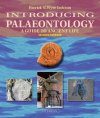![Introducing Palaeontology Introducing Palaeontology]()
Click to have a closer look
About this book
Contents
Customer reviews
Biography
Related titles
About this book
Life on Earth can be traced back over three billion years into the past. Many examples of the Earth's former inhabitants are to be found in rocks, preserved as beautiful and fascinating fossils. The earliest life forms were bacteria and algae; these produced the oxygen that enabled more complex life forms to develop. About 600 million years ago multi-cellular organisms appeared on Earth, some of which could protect themselves with hard parts such as shells. Many of these life forms were readily fossilized and are used to subdivide geological time. Numerous species have evolved and most are now extinct. Lineages can be traced and extinctions explained as a consequence of terrestrial and extra-terrestrial events. Now in a revised, updated and expanded Second Edition Introducing Palaeontology will continue to provide readers with a concise and accessible introduction to the science of palaeontology.
Contents
Part 1: the science of palaeontology
1.1 Preface: the fascination of fossils
1.2 A chancy business: the preservation of fossils
1.3 From the field to laboratory: how to collect, curate and study fossils
1.4 Code of conduct for fossil collectors
1.5 Taxonomy: how to classify and identify fossils
1.6 Uses of fossils
1.7 Fossil Lagerstatten: exceptional preservation of fossils
1.8 Early ideas on the nature and significance of fossils
Part 2: Fossil Groups
2.1 Algae and vascular plants
2.2 Unicellular animals: Foraminifera and Radiolarians
2.3 Sponges
2.4 Cnidiria
2.5 Bryozoans
2.6 Molluscs
2.7 Brachiopoda
2.8 Echinoderma
2.9 Arthropods
2.10 Graptolites
2.11 Conodonts
2.12 Fishes
2.13 Tetrapods and Amphibians
2.14 Reptiles
2.5 Birds
2.16 Mammals
2.17 Hominids and Hominins
2.18 Trace Fossils. Glossary
Customer Reviews
Biography
Patrick Wyse Jackson is a Senior Lecturer in Geology and Curator of the Geological Museum at Trinity College, Dublin.
Popular Science
By: Patrick N Wyse Jackson(Author), John Murray(Illustrator)
158 pages, colour & b/w photos, colour & b/w illustrations
"Introducing Palaeontology is an excellent book, full of attractive diagrams and photographs, coupled with short, waffle-free sections. The combination of short, snappy chapters and interesting scientific concepts create a book that is perfect for anyone new to the science of palaeontology, whether they be an enthusiastic amateur, a prospective student or an undergraduate just starting out in the field."
– Geological Magazine
"There has been a gap in the market for a long time, for a book that provides a simple introduction to fossils, this title fills that gap admirably! In 150 pages it takes the reader on a whistle stop tour through many aspects of palaeontology. The book rounds off with an excellent glossary. What can I say? This book is perfect for its purpose!"
– Down to Earth
"And thank goodness this isn't another "Guide to Identifying Fossils in the Field", which is a genre that is about as much use as a chocolate fireguard, when it comes to identifying any fossil below the level of kingdom or phyla (I exaggerate)! In fact, this makes no such claim – instead, being a short (152 pages), colourfully and beautifully illustrated (in part by John Murray) introduction to the science of palaeontology and, as such, fills a useful and previously empty niche in the market for both amateurs and first/second year students at university. Like Introducing Geology, the book is written in clear, understandable English, but never underestimates the reader's geological abilities or intelligence."
– Deposits Magazine
"I would recommend this as one of the best introductory texts on the subject around at present and no doubt its fine illustrations will soon begin to punctuate many introductory courses in our science."
– European Geologist





































